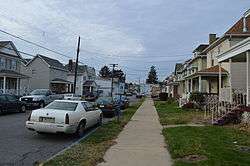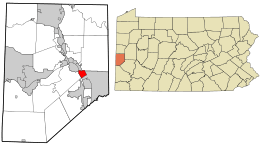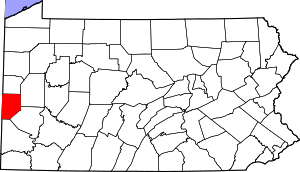Conway, Pennsylvania
Conway is a borough in Beaver County, Pennsylvania, United States, located along the Ohio River. At the 2010 census, the borough had a total population of 2,176.
Conway, Pennsylvania | |
|---|---|
| Borough of Conway | |
 Houses on Second Avenue | |
 Location in Beaver County and the U.S. state of Pennsylvania. | |
| Coordinates: 40°39′48″N 80°14′10″W | |
| Country | United States |
| State | Pennsylvania |
| County | Beaver |
| Incorporated | 1902 |
| Government | |
| • Type | Borough Council |
| Area | |
| • Total | 1.46 sq mi (3.78 km2) |
| • Land | 1.28 sq mi (3.31 km2) |
| • Water | 0.18 sq mi (0.47 km2) |
| Elevation | 909 ft (277 m) |
| Population (2010) | |
| • Total | 2,176 |
| • Estimate (2019)[2] | 2,067 |
| • Density | 1,619.91/sq mi (625.30/km2) |
| Time zone | UTC-5 (Eastern (EST)) |
| • Summer (DST) | UTC-4 (EDT) |
| Zip code | 15027 |
| Area code(s) | 724 |
| FIPS code | 42-15872 |
| Website | www |
Conway is the site of the Conway Yard, a major railroad classification yard and locomotive facility, owned by the Norfolk Southern Railway. From 1956 until 1980, it was the largest rail yard in the world.
Geography
Conway is located at 40°39′48″N 80°14′10″W (40.663466, -80.235981).[3]
According to the United States Census Bureau, the borough has a total area of 1.5 square miles (3.9 km2), of which, 1.2 square miles (3.1 km2) of it is land and 0.2 square miles (0.52 km2) of it (13.70%) is water.
Surrounding and adjacent neighborhoods
Conway has three land borders with Freedom and New Sewickley Township to the north, and Economy from the east to the south. Across the Ohio River, Conway runs adjacent with Monaca and Center Township.
Demographics
| Historical population | |||
|---|---|---|---|
| Census | Pop. | %± | |
| 1910 | 1,483 | — | |
| 1920 | 1,858 | 25.3% | |
| 1930 | 2,014 | 8.4% | |
| 1940 | 1,865 | −7.4% | |
| 1950 | 1,570 | −15.8% | |
| 1960 | 1,926 | 22.7% | |
| 1970 | 2,822 | 46.5% | |
| 1980 | 2,747 | −2.7% | |
| 1990 | 2,424 | −11.8% | |
| 2000 | 2,290 | −5.5% | |
| 2010 | 2,176 | −5.0% | |
| Est. 2019 | 2,067 | [2] | −5.0% |
| Sources:[4][5][6] | |||
At the census[5] of 2000, there were 2,290 people, 988 households, and 656 families living in the borough. The population density was 707.3/square kilometre; (1,825.3/square mile). There were 1,026 housing units at an average density of 316.9/square kilometre; (817.8/square mile). The racial makeup of the borough was 98.25% White, 1.27% African American, 0.04% Native American, 0.04% from other races, and 0.39% from two or more races. Hispanic or Latino of any race were 0.48% of the population.
There were 988 households, 23.7% had children under the age of 18 living with them, 53.8% were married couples living together, 8.9% had a female householder with no husband present, and 33.6% were non-families. 31.0% of households were made up of individuals, and 19.2% were one person aged 65 or older. The average household size was 2.30 and the average family size was 2.87.
In the borough the population was spread out, with 18.7% under the age of 18, 7.1% from 18 to 24, 25.4% from 25 to 44, 25.4% from 45 to 64, and 23.4% 65 or older. The median age was 44 years. For every 100 females, there were 89.4 males. For every 100 females aged 18 and over, there were 85.4 males.
The median household income was $34,181 and the median family income was $46,250. Males had a median income of $36,167 versus $23,516 for females. The per capita income for the borough was $18,699. About 4.8% of families and 7.6% of the population were below the poverty line, including 7.1% of those under the age of 18 and 10.0% of those ages 65 and older.
See also
- List of cities and towns along the Ohio River
References
- "2019 U.S. Gazetteer Files". United States Census Bureau. Retrieved July 28, 2020.
- "Population and Housing Unit Estimates". United States Census Bureau. May 24, 2020. Retrieved May 27, 2020.
- "US Gazetteer files: 2010, 2000, and 1990". United States Census Bureau. 2011-02-12. Retrieved 2011-04-23.
- "Census of Population and Housing". U.S. Census Bureau. Retrieved 11 December 2013.
- "U.S. Census website". United States Census Bureau. Retrieved 2008-01-31.
- "Incorporated Places and Minor Civil Divisions Datasets: Subcounty Resident Population Estimates: April 1, 2010 to July 1, 2012". Population Estimates. U.S. Census Bureau. Archived from the original on 11 June 2013. Retrieved 11 December 2013.
